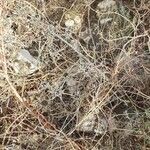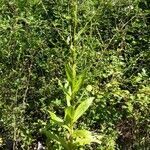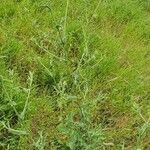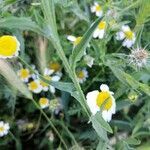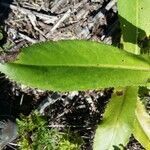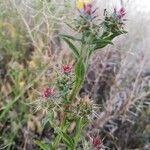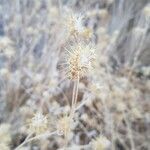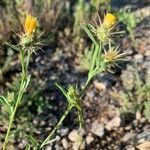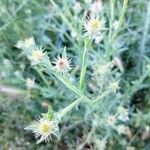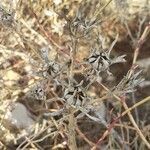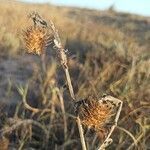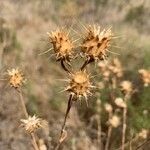Annual or biennial. Stems erect, ribbed, branched above, (10)-25-60 cm tall, with sparse to dense multicellular and cobwebby hairs. Lvs decurrent on stems, with both short curved and sparse cobwebby hairs; lower lvs oblanceolate to spathulate, toothed to lyrate-pinnatifid, 5-8 × 0.5-1.5 cm; upper lvs linear-spathulate to linear-lanceolate, becoming smaller. Capitula shortly stalked or subsessile, often clustered. Involucre broadly ovoid to globose, (6)-8-12 mm diam.; outer and middle bracts ovate, not veined, glabrescent or with sparse to dense cobwebby hairs; appendages recurved to spreading, not covering bracts, spinous, not narrowed at junction with bract, not decurrent on bract; terminal spine 6-10 mm long, pale or red-brown; lateral spines (2)-3-(4) on each side, 1-3 mm long, in (1)-2-(3) pairs at base of terminal spine, the other pair in basal ⅓ of terminal spine. Florets yellow, the outer slightly radiate. Corolla densely clothed in glandular papillae. Achenes c. 3 mm long, pubescent; pappus c. 2 mm long.
Annual herb, 200-500 mm high. Stems angular, narrowly winged, scabridulous. Leaves basally crowded and alternate along stem; basal leaves petiolate, blade narrowly obovate to lyrate-pinnatilobed, lobes few, narrow, margins entire or dentate; stem leaves sessile, blade oblong, mostly entire, sometimes weakly sinuate or dentate, bases decurrent, pubescent to scabridulous. Heads discoid, solitary or in small groups, terminal, on short branches. Involucral bracts glabrous, in many rows, imbricate, outer bracts tipped with deflexed spine up to 8 mm long and at its base 1 pair of lateral spines, additionally also 2 or 3 pairs of shorter spines on margin of bract, innermost bracts with reduced apical spine and lateral spines absent. Flowers: disc florets only, bright yellow; June and Nov. Fruit with cypsela pale brownish purple, oblong, laterally compressed. Pappus of paleaceous setae in many rows, 2-3 mm long.
Annual or biennial to 0.8 m high. Stems with sparse arachnoid and short scabrid hairs, becoming glabrous; wings present. Cauline leaves linear to narrowly lanceolate, entire, green above and below, sparsely to densely scabrid; sessile glands present. Capitula solitary or occasionally 2 together, pedunculate; involucre ovoid to globose, 7–11 (–13) mm diam. at anthesis; median involucral bracts elliptic to ovate, 4–7 mm long, 2.5–3 mm wide, with arachnoid hairs; appendages comprising a straight, patent, pungent, terminal spine 3–7 mm long with (2 or) 3 pairs of lateral spinules, the distal pair about halfway along spine. Florets yellow; inner (fertile) florets with tube 7–10 mm long, glandular, and lobes 1.3–2 mm long; sterile florets c. same length as fertile florets. Anthers 3–3.5 mm long. Achenes cylindrical, 2.5–3 mm long, sparsely hairy, brown. Longest pappus bristles 2.0–2.5 mm long, white.
Annual 1.5–7 dm, lightly arachnoid when young and with some more persistent coarser crisp hairs; stem narrowly winged by the decurrent lf-bases; basal and lower cauline lvs oblanceolate, toothed to lyrate-pinnatifid, 3–15 cm × 5–35 mm, usually deciduous; middle and upper lvs smaller, becoming linear-oblong and entire; invol 8–15 mm, broad-based, its middle and outer bracts slenderly spine-tipped, the central spine 5–9 mm; inner bracts weakly spinose or merely tapering, not at all enlarged apically, generally purple-tinged; fls yellow; pappus 1.5–3 mm; 2n=24, 36. A weed in waste places; native of the Mediterranean region, occasionally found in our range. June–Sept.
Erect herb to 1 m high; stems branched, narrowly winged.. Leaves sessile, elliptic, 4–15 cm long, 0.3–1 cm wide, margins entire or sometimes pinnatilobed in lowermost leaves, hispid-pubescent.. Capitula solitary and terminal on short lateral branches; involucre 10–17 mm long; phyllaries ovate, 12 mm long, with spiny terminal appendages; receptacle with setae to 7 mm long.. Corolla yellow, the marginal florets neuter; inner florets 8–12 mm long.. Achenes pale brown, 2.5–3 mm long, glabrous or puberulous; pappus of unequal setae, the inner to 3 mm long, the outer narrow and scale-like, 0.5–1.5 mm long.
Annual herb, 0.3-0.6 m high; with stiff erect or ascending winged stems, cottony. Leaves deeply lyrate-pinnatifid, lobes distant, narrow, entire or toothed; cauline leaves oblong-lanceolate, commonly entire, sometimes sinuate or toothed, sessile, greyish white-cottony above and below. Capitula solitary, terminating short lateral branches, subsessile; involucral bracts appendaged with terminal, brownish, spreading spines pinnately arranged, short. Florets yellow, glandular. Flowering time Sept.-Apr. Pappus of long and short scales, persistent. Cypselae glabrous.
Phyllaries imbricate, increasing in length towards the inside, coriaceous, glabrous, appendaged; appendages of outer phyllaries brownish or purple, each with a deflexed apical spine 5–7 mm. long and 2–3 pairs of pinnately arranged short lateral spines; appendages of innermost phyllaries with the terminal spine reduced and the lateral spines absent, often expanded and chartaceous.
Annual herb, 200-500 mm tall. Basal leaves narrowly obovate, lobed; stem leaves the same but mostly entire, sometimes weakly toothed, bases decurrent, pubescent to scabridulous. Heads discoid. Involucral bracts tipped with long spine and at its base 2 or 3 pairs of shorter spines. Flowers bright yellow.
Achenes pale brownish-purple, c. 3 mm. long, oblong, somewhat laterally compressed, sparsely finely puberulent, attachment-scar lateral and oblique-concave; pappus many-seriate of persistent unequal paleaceous setae up to c. 3 mm. long.
Cauline leaves sessile, up to c. 4 x 0.5 cm., oblong-lanceolate, entire, sometimes sinuate or dentate, decurrenton the stem as narrow wings, hispid-pubescent or young growth ± sericeous-araneose at first.
Florets yellow, glandular otherwise glabrous; marginal florets neuter; disk-florets hermaphrodite, 8–12 mm. long, narrowly infundibuliform, limb 4.5–5.5 mm. long, lobes c. 1.5 mm. long.
Basal leaves up to c. 10 cm. long, narrowly obovate to lyrate-pinnatilobed; lobes few, remote, narrow, entire or dentate.
Capitula solitary and terminal on short lateral branches; involucres c. 12 mm. long, urceolate, araneose.
Stems slender, stiffly branched, angular, narrowly winged, scabridulous.
Receptacle densely setose; the setae c. 7 mm. long.
An erect annual herb up to c. 1 m. tall.
